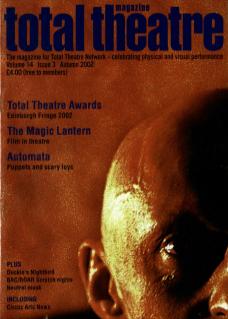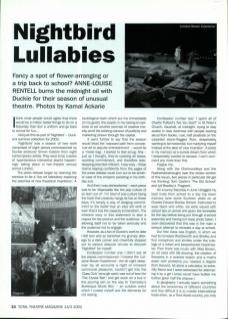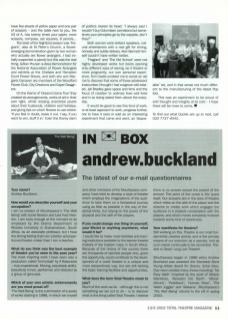I think most people would agree that there would be a million better things to do on a Saturday than don a uniform and go back to school for fun...
I did just this as part of Nightbird – Duckie's summer collection for 2002.
Nightbird was a season of new work comprised of eight pieces commissioned by Duckie producer Simon Casson from eight contemporary artists. They were to be a series of 'spontaneous interactive playful happenings' taking place in non-theatre venues across London.
The press release began by claiming the exercise to be ‘a live art laboratory exploring the potential of new theatrical inventions'. A tautological claim which put me immediately on my guard, the sceptic in me raising an eyebrow at yet another promise of creative novelty amid the existing clamour of publicity and marketing strewn through the capital.
It went further to say that the season would tread the ‘wayward path from conceptual art to popular entertainment – would be a mixed bag'. I started to feel smug: Aha – just as I thought, they're covering all bases, avoiding commitment, and therefore sidestepping potential criticism. I was wary – these claims leaping confidently from the pages of the press release could turn out to be another case of the emperor parading in his birthday suit.
And then I was disheartened – each piece was to be ‘disposable like the pop culture (it is) born out of’. I'm tired of pop culture being the hook that creativity hangs its hat on these days; it's simply a way of dodging commitment to the belief that an idea will work or even that it has the capacity to transform. The inherent irony in this statement is also a cop-out for the product and the audience. It is allowing itself not to be taken seriously and the audience not to engage.
However, as a fan of Duckie's work to date I felt torn and so banished my grumpy alter ego to a dark corner and cheerfully stepped out to various obscure venues to discover Nightbird for myself.
Confession number one: I didn't see all the pieces commissioned. I missed the Lorraine Bowen Experience, the all-night sleepover (by all accounts a night of innocent communal pleasure); couldn't get into the Class Club (enough said); was out of town for The Crystal Ball; and got stuck on a bus in the pouring rain on the way to Carnesky's Burlesque Ghost Box – an outdoor event which I cursed myself and the elements for not seeing.
Confession number two: I spent all of Charlie Pulford's Are You God? in St Peter's Church, Vauxhall, at midnight, trying to stay awake in near darkness with people reading aloud from books. I sat, half prostrate on the carpeted stone-flagged floor, desperately wanting to be horizontal, but martyring myself instead at the altar of ‘new invention'. It exists in my memory as a surreal dream from which I desperately wanted to escape. I can't comment any more than this.
Forgive me.
Along with the Cholmondleys and the Featherstonehaughs (see the review section of this issue), two pieces in particular did get me thinking: Tom Castle's The Old School and Jyil Bradley's Fragrant.
On a sunny Saturday in June I dragged my best mate from school to a day trip down memory lane some fourteen years on at Charles Edward Brooke School. Instructed to wear black and white, we were issued with school ties on arrival and given the timetable for the day before being put through a school assembly and having our class photo taken. I soon discovered that this was in the main a serious attempt to recreate a day at school.
Our first class was English, in which we had to compare Wordsworth and Shelley and find metaphors and similes under the tutelage of a robed and bespectacled headmaster. Then there was music with Miss Bowen, an art class with life drawing, the creation of fireworks in a science lesson, and a maths exam with problems you needed a degree from Harvard, let alone a calculator, to solve. (My friend and I were ostracised for attempting it by a girl I know would have bullied me further given half the chance.)
In geography I actually learnt something about the economies of different countries and how difficult it is to master international trade when, as a Third World country, you only have five sheets of yellow paper and one pair of scissors – and the table next to you, the US of A, has twenty times your paper, more scissors, compass, set squares, six pencils...
The treat of the Nightbird season was Fragrant, also at St Peter's Church, a flower arranging demonstration given by two women who actually are flower arrangers. I had initially suspected a parody but this was the real thing. Gillian Poulain is Area Demonstrator for the National Association of Flower Arrangers and exhibits at the Chelsea and Hampton Court Flower Shows, and both she and Margaret Canavan are members of the Woodford Flower Club, City Creations and Capel Designers.
On the theme of 'Dreams Come True' they created six arrangements, works of art in their own right, whilst relating anecdotal pearls about their husbands, children and holidays, and giving tips on which flowers to use where: 'If you feel in doubt, leave it out. I say, if you want to win, stuff it in.' Even the thorny stem of politics reared its head: 'I always said I wouldn't buy Columbian carnations but sometimes your principles go by the wayside, don't they?'
Both women were brilliant speakers, natural entertainers with a real gift for timing, honesty and subtle delivery. Alan Bennett himself couldn't have written better.
Fragrant and The Old School were not highly developed works but doors opening onto different ways of seeing, be it theatre or more poignantly, our own personal experience. Tom Castle enabled me to revisit an old me to discover that some of those adolescent insecurities I thought I had outgrown still existed. Jyll Bradley gave space and time and the focus of creation to ordinary lives well lived and in so doing raised them above the everyday.
It would be good to see this kind of work, or at least approach to work, progress further, not to have it exist or sold as an interesting experiment that came and went, as ‘disposable' tat, and in that sense not much different to the manufacturing of the latest Pop Idol.
This was an experiment to be proud of with thought and integrity at its core – I hope there will be more to come.


